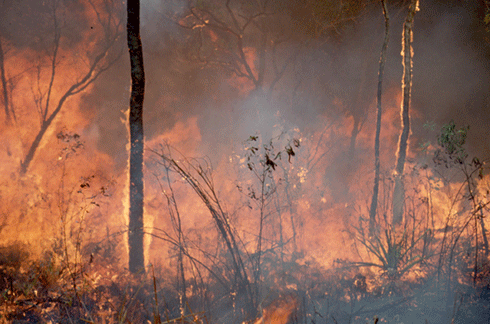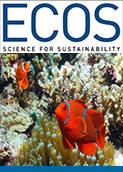
|
Published: 10 November 2014
The science of living with fire
The bushfire season isn’t wasting any time this year. There have already been large fires in South Australia and NSW, and the obligatory ‘the state is a tinderbox’ warnings came out months ago.

|
|
Fire in tropical Australia. Credit:
scienceimage/CSIRO
|
There were bushfires in July in NSW, and the number of local council areas in southern Australia declaring the fire season open in August - it starts in July up north - has more than doubled.
So a program on SBS TV on bushfires is timely. Inside the Inferno is a 2-part program that began screening last week; the second part can be seen at 8:30pm Wednesday (12 November).
While it’s mainly about the everyday heroes who volunteer to fight bushfires, there’s a fair bit about the science of bushfires. CSIRO contributed to the program, but much more importantly, its research helps keep people safe from fires.
You might be surprised at how much of CSIRO’s work has a connection to fires.
Let’s start with prediction. Wenju Cai and his team at CSIRO’s Oceans and Atmosphere Flagship have been working to get a better understanding of the El Niño Southern Oscillation (ENSO) and its lesser-known counterpart, the Indian Ocean Dipole (IOD).
The team’s groundbreaking work has established that the IOD ‘pre-conditions’ south-eastern Australia for major bushfires, and has enabled us to stretch out the prediction range for severe fire activity to between four to six months. What you can predict, you can plan for.
And you need to know exactly what you’re planning for. That’s what the Pyrotron helps researchers do. It’s a 25-metre-long fireproof wind tunnel, with a working section for conducting experiments and a glass observation area.
It’s used to study - safely, under controlled conditions - how fires ignite in bushfire fuel and how they spread. This critical work can’t be done in the field under wildfire conditions. Using the Pyrotron, researchers can study the mechanisms of bushfires’ spread, their thermokinetics - the chemistry of combustion - and fuel consumption, and their emissions and residues under different burning conditions.
Fire researchers and managers won’t ever be able to prevent fires breaking out. They can plan, they can study, but they can’t change the nature of Australia. They can’t stop hot, dry days or lightning strikes.
The challenge for them is to find acceptable ways for Australians to live with bushfires while retaining the ability to choose where and how they live. They also need to understand the risks that bushfires pose to different types of construction. They need to know what’s safest and strongest, and how to build it.
CSIRO researchers have surveyed every bushfire involving significant house loss since the 1983 Ash Wednesday fires, and tested a variety of construction methods to find optimal building types for fire-prone areas. How do they test them? They set fire to them.
It’s not just how resistant the buildings are to collapsing into a pile of ashes that’s important, although obviously that’s a major consideration. They also need to know what kind of house would afford the best shelter and defence in the event of bushfire attack.
This research requires CSIRO scientists to use their expertise in:
-
assessment of bushfire risk at the urban interface
-
integrated urban design solutions including whole-of-life energy and water use, biodiversity, landscapes, cultural value systems, lifestyle expectations, and risk from other sources
-
analysis of major bushfire events
-
development of fire-spread prediction models and tools
-
evaluation of fire suppressants and applications
-
post-incident analysis of bushfire impact on houses and people
-
fire characteristics at the urban interface
-
community education
-
performance of materials during bushfire exposure
-
characterisation of materials or systems performance in bushfires
-
product development, verification and enhancement for use in bushfire-prone areas (specialist coatings, glazing protection, timber deck design), and
-
fire fighter vehicle burn over protection systems.
CSIRO also works on disaster management tools for fires. Its researchers developed the Emergency Response Intelligence Capability (ERIC) in collaboration with the Australian Government Department of Human Services Emergency Management team.
This uses information from a range of sources and includes:
-
region data from the Australian Bureau of Statistics
-
context data including demographics and details of the natural and built environment
-
‘live’ data feeds describing the emergency event as it progresses and the historical record of previous ‘live’ data feeds, and
-
an archive of previous situation reports.
This information can be focused for a specific region and collated semi-automatically to generate ‘situation reports’, which include information synthesised from available datasets augmented by user-provided content. The situation reports describe what the event is, where it is located and the impact on the local community and to the department.
These days, social media is one of the most important channels when a disaster is unfolding, and CSIRO researchers have been working on that too. Every minute, vast amounts of information are communicated via Twitter. The challenge for researchers is to make the relevant information accessible to emergency services. A huge amount of detail about the 2009 Victorian bushfires was reported in real-time on social network sites. The trouble was that state and federal disaster response agencies couldn’t see it.
CSIRO has created Emergency Situation Awareness (ESA) software to detect unusual behaviour in the Twittersphere and alert users in the emergency services if a disaster is unfolding online.
So that’s CSIRO’s contribution to helping keep people safe from bushfires, and - if worst comes to worst - in them.
Virginia Tressider is a science communicator with CSIRO. This is a lightly edited post from the news@CSIRO blog.



